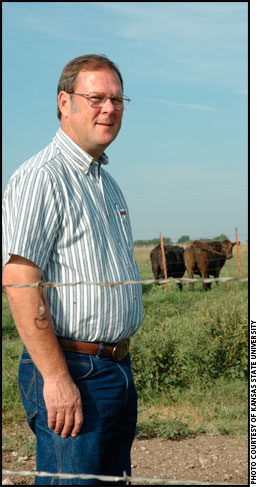
Lyle Lomas, Kansas State University
Stockers Set Up Beef Quality
The stocker segment is a critical link that can influence performance and carcass characteristics later in life.
Genetics were selected years ago; calving and weaning are complete, so the next place that really matters in the beef production chain is the feedlot. Right?
Not necessarily. A sandwich relies on what's between the bread slices; a great book must be compelling from cover to cover; and, likewise, the cattle industry often counts on the stocker phase to ensure cattle quality while moving them from ranch to feedlot.
"A growing body of research shows that the stocker segment is a critical link that can influence performance and carcass characteristics later on," says Larry Corah, vice president for supply development at Certified Angus Beef LLC (CAB). "Health continues to be an important variable to control, but two recent studies dial down into some specific nutritional management that could make a difference."
Kansas State University (K-State) work found that supplementing calves on smooth bromegrass pastures with a grain-sorghum ration increased subsequent marbling scores without having a negative effect on feedlot performance.
The three-year study looked at fall-born Angus calves grazing brome pastures from mid-April until early November. Cattle supplemented with 3.6 pounds (lb., dry-matter basis) per day ended up with the highest hot carcass weight, at 775 lb., and the highest marbling score. More than 86% reached USDA Choice, while the non-supplemented calves fell to 78.5% Choice. Those in the control group gave up 32 lb. of carcass weight and had average daily gains (ADGs) similar to their grain-eating counterparts.
"The results of this study are consistent with those from other research. Calves that are creep-fed at a young age tend to have greater marbling scores and quality grade than those that did not consume creep feed," says K-State researcher Lyle Lomas. "We were supplementing grazing cattle with starch when they were at the optimal age for intramuscular cell hyperplasia. That provided an opportunity for greater marbling during the subsequent finishing phase."
Lomas notes the increases in marbling were "small, but consistent," and can boost the bottom line when combined with those added pounds.
"Typically more pounds mean more total dollars," he says. "But sometimes it's difficult for a producer to determine what their marketing plan is going to be for their cattle."
They may not know if they're going to sell them after backgrounding or retain ownership through harvest, he says.
 "If they do put some additional pounds on the cattle during the grazing phase with a low level of energy supplement, it won't have a negative effect on finishing performance. And it may allow them to capture more dollars whenever they choose to sell them," Lomas says.
"If they do put some additional pounds on the cattle during the grazing phase with a low level of energy supplement, it won't have a negative effect on finishing performance. And it may allow them to capture more dollars whenever they choose to sell them," Lomas says.
The added quality grade is an extra that can pay dividends if the cattle are grid-marketed when finished.
David Lalman, of Oklahoma State University (OSU), says preliminary research suggests sale method should determine your implant program.
An OSU study showed implants improved average daily gain, from 9% to 15%, but had a tendency to cut marbling by as much as 3.2%. Although results are based on a small number of cattle, they dropped from 78% Choice to 64% when implanted. The Certified Angus Beef® (CAB®) brand percentage was cut in half (32% to 16%).
"It would be a matter of taking that average response and working out the economics based on [a] grid marketing system, then weighing that against the positive performance," Lalman says. "If you're going to retain ownership, or are marketing those cattle to someone who is involved in grid marketing, it could be important."
Even the cattle on an extended grazing program — native range followed by wheat pasture — gained 2.5 lb. per day, and Lalman says those high gains should help quality.
"When cattle are stressed nutritionally for a very long period of time, you can expect carcass quality to be impacted in a negative way," he says. "These cattle were always on a positive plane of nutrition."
A restricted diet should give stocker operators pause to consider their use of growth promotants.
"If you implant cattle with a fairly aggressive program in the face of a maintenance- or negative-plane of nutrition, the negative impact on grade is magnified," Lalman says.
As feeders pay more attention to source and final outcome, it becomes ever-important for stocker operators to weigh all the variables that affect marbling and gain, Corah says.
"They watch where cattle come from and how they do, so it's in a producer's best interest to give them every possible chance to ring all the bells at harvest," he says.
For more information on quality-focused stocker programs, visit www.cabpartners.com/bestpractices/stocker.php.




